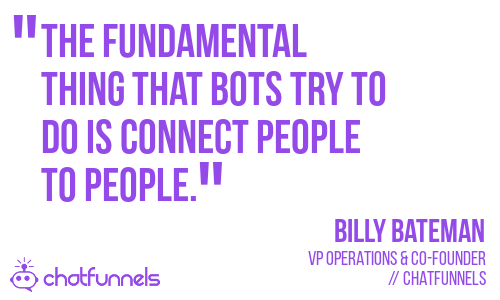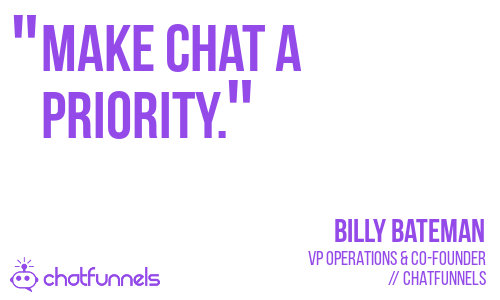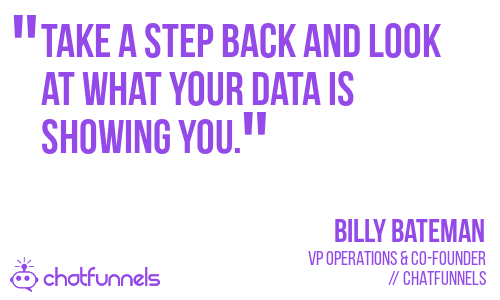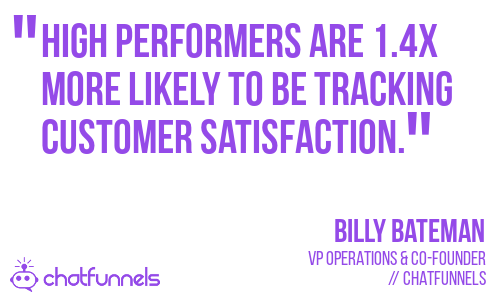4 Key Findings from the Salesforce State of Marketing Report

Overview: This week on digital conversation Billy Bateman analyzes the State of Marketing Research Report by Salesforce. He focuses on customer experience, making customer engagement a priority and taking time to look at the data.
Guest: Billy Bateman- Billy Bateman is the Co-Founder and VP of Operations for ChatFunnels, a digital conversation analytics, and optimization solutions provider. He has a background in digital marketing, business operations, and entrepreneurship.
Billy grew up in Idaho and graduated from Brigham Young University and has a Masters of Business Administration from Boise State University. While at BSU, he completed Boise State’s Venture College Entrepreneurship Program and became a mentor and entrepreneurial lead on a technology commercialization project. He is an avid outdoorsman and enjoys fishing and hunting.
Listening Platforms:

Alright, everybody welcome the show today, there’s no guests this week with the corvid19 going around, people that focus up on their businesses and taking care of their families, but we still want to get an episode out; so, today I’m going to go through and talk about a report and some research that I’ve been digging into and how as marketers we can use this and leverage the insights here in your conversational marketing and how you’re using chatbots, how you’re using live chat and go through a few of these things and realize you know, some of these problems are actually great opportunities for BOTs.
So, it’s the sales force, a state of marketing fifth edition and just want to hit a few points here and discuss them and then please, I’d love to have everybody reach out on social and give me your thoughts on how we can leverage these things as marketers. So, the first thing that I wanted to hit was, what they found is 84percent of customers saying being treated like a person and not a number is important in winning their business, but only 54percent of the high performing marketing teams, feel that they are leading with customer experience and that’s really a focus for them and the high performers make up only 16percent of all the marketers surveyed.
So, one of the things we can do with BOTS and with live chat, is really engage people with personalized experiences and even with a BOT try to hit once you give that BOTs a little bit of personality and you build it the right way, so that people realize the expectations like; okay this BOTS trying to help me and it can only help me do so much, but making sure that we build in that somebody’s actually watching this, in real time; as much as possible paying attention to and we can set up flags and notifications to realize maybe somebody is, maybe stuck or is asking for something else and jump in and engage them with a live chat and connect people, the people is really one of the things I’ve always believed with BOTS.

When we’re building BOTS for customers, for ourselves, we’re designing these things like the fundamental thing we’re trying to do; is connect people to people and maybe we’re using the BOTs to automate, getting them to the right person or helping them find the right piece of content or accomplish whatever task they’re after, to get more information, it’s really about trying to give them an experience that solves their needs and answers their questions right off the BOTs.
So, if you’re already one of the marketers doing that, will give yourself a pat on the back, because you’re doing a good job, but if you’re you know if you feel like; I’m trying to solve this customer experience and this is customer journeys and how we’re working those in, and you’ve got a BOT, you’ve got something in like an intercom or a drift or HubSpot, even has their own chat BOT and where you’ve just got a live chat on the site, look at your data and see where does it make sense to engage people really quickly and with what type of messaging; and most of these are smart enough that you can look at the dig into the data of what do people who book meetings look like; what does that what does their customer journey look like, what does people who’d aren’t moving on, what is their journey looking like as well and maybe we can try to help them a little more and engage them and maybe it’s tweaking the website, maybe it’s adding in, adding in some BOTS or some live chat along the way to try and engage them and help them figure out, how we how you can help them as business.
So, that was the first thing that I wanted to hit, is we really got to think about the experience we’re providing with these BOTs, we can build a BOTs that’s; all I do is book a demo for you, but maybe giving them a bailout and the way to say, that’s actually not what I want, I just want to talk to somebody and being proactive and letting them have that way, is a great way to solve that customer experience.

The next one which I think is even a better fit for conversational marketing and its digital conversation space, is the marketer’s top priorities and their top challenges they found. Number one priority was engaging with customers in real time; well BOTS and live chat, are great for engaging customers right there on the site, while they’re looking at your information, but their top challenge was the exact same; engaging with customers in real time. One of the great ways to do this, I already said is get that live chat on your website and be proactive and make it a priority for your team, if you’re going to put chat on the site, it drives me nuts, when you see people who are like; yep, we’ve got live chat, talk with us and it’s during what their business hours are it’s the middle of the day, it’s Wednesday afternoon, their office is you know on the west coast and it’s three o’clock, West Coast time and nobody is responding.
If you’re going to put it on your site, just make sure you do it the right way and you’re responsive. The number one indicator that we’ve found for success with live chat is, just that response time, that when somebody chats in, you get to them quickly and was quickly look like, everyone’s a little bit different, but generally our benchmark is under a minute, if your team averages is under a minute for that response time, you’re doing pretty good and you’re getting it; most people will hang around and wait and realize there may not be somebody just sitting here waiting for chats all day, but if you’re there and under a minute to talk to them, then they’re going to have a conversation and be able to engage those customers.

The next thing I wanted to really just hit was, we have, they looked at how many data sources that we’re using in marketing operations to understand our customers and prospects and in 2017, it was ten and that’s gone up on average to 15 in 2010 and so; well, that’s great we have more places that we’re getting information from, keeping all of that together, looking at it and being able to consolidate it to get make decisions, dude that’s tough and if you’re not looking at knowing all your integrations between these different tools and data sources and taking the time to take a step back and look at the big picture and what your data is showing you, you’re missing out and I’m not, that’s not news to anybody.
But what you got to do is, this is what our Consulting Group does is, we’re going to go back in and look at your data and figure out; okay, where are we missing people along their journey and what does that journey look like for each customer and are there places that we’re missing out, that we should be engaging people or at least giving them the opportunity to engage you in real time. So, make sure that you’re, that you’re owning that data and taking the time to use it, if we’ve got all this information; why are we still struggling, well I think it’s because we’re waiting for the information to tell us all the answers and you’ve got to sit down and dig into the numbers, like taking a day or two a month where you’re not producing anything, where you’re just looking at looking at the data and really analyze in it and forming your hypothesis and your next steps and new experiments to run, that’s going to pay off for you.

Okay, the last point that I wanted to hit was tracking customer satisfaction metrics and customer lifetime value. So, what they found in this report is that the high performers versus underperformers we’re 1.4 times more likely to be tracking customer satisfaction metrics and that’s huge and most of these, most of your conversational marketing platforms, you can ask people when they’re at the end of the BOTs flow, that’s just like a little, little add-on; hey, you know how satisfied were you with this set, with this conversation and in track and it seems like Oh, an extra annoyance that we’re asking the customer this; like did we do a good job, should we even be asking them that, but what this data tells me is we probably should be asking them that, if you want to be in that high performer category, you should be asking them; hey, we built this BOTs, we tried to help you do this task, subscribe to our newsletter, get connected to somebody for live chat or even just chat with somebody, did we do a good job, so that we can look at that and say what can we do better.
So, if you want to be a high performer, you can look at your NPS scores, once you’ve got customers, you can look at all down the customer funnel, but if you’re using conversational marketing to engage customers and you have the option to ask them, how we did and if they were satisfied or not; very easily whenever they interact with you, I think you should be doing that. Though, and then, one other point was just that high performers, we’re also more likely to be tracking the lifetime value of customers, so that these marketing teams actually pay attention to; okay you know we’re getting customers, but are we getting customers that that end up being a good payback for the company, well we’re getting the right customers in there.
So, it’s a great report, we’ll link to it here in the podcast, I would ask anyone like, hey, if you’re really, you really want to be great and you should look at this and then look in the mirror and see okay, where are we falling short as a marketing team and what can we do better and give yourself a pat on the back for what you already are doing.
So, it’s the Salesforce state of marketing, fifth edition we’ll have a link to it in the podcast. Thanks everybody for listening and we’ll chat next week.
